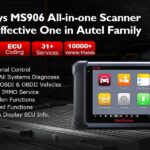VCDS (Vag-Com Diagnostic System) is a powerful diagnostic software for Volkswagen, Audi, Seat, and Skoda vehicles. Finding a reliable French version for free can be challenging. This guide explores VCDS 21.9 FR, installation procedures, potential issues, and solutions.
Understanding VCDS 21.9 FR and its Loader
VCDS 21.9 FR offers a French-language interface for easier navigation and comprehension for French-speaking users. Often, this version comes with a loader, version 9.2 in this case, designed to bypass certain restrictions and enable functionality with non-official diagnostic cables.
Installation Guide for VCDS 21.9 FR
Before you begin, remember to disable antivirus software, Windows Defender, and configure your firewall to block VCDS. These precautions are necessary to prevent interference during the installation process, as the loader might be flagged as suspicious.
Here’s a step-by-step installation guide:
- Install the Software: Run the VCDS-FRM-21.9.0-Installer.exe file. If you have a 64-bit system, install both 32-bit and 64-bit versions if available.
- Do Not Run VCDS Yet: After a successful installation, refrain from launching the VCDS software.
- Copy the Loader: Locate the VCDSLoader.exe file (often found on the installation CD or within the downloaded files) and copy it to the VCDS installation directory (typically C:Ross-TechVCDS FRM). Create a desktop shortcut for easy access.
- Initial Cable Test: Connect your diagnostic cable to the PC. Run VCDSLoader.exe. Click on “Options,” then “Test,” and finally “Save.” This step establishes communication between the cable and the software.
- Run VCDS with Loader: Disconnect the cable, close the loader, and then connect the cable to your car’s OBD-II port. Launch VCDSLoader.exe again. This should start VCDS 21.9 FR.
Example of a VCDS cable connected to a car’s OBD-II port.
Troubleshooting Common Issues
“Interface Not Found” Error: This common error indicates a problem with cable compatibility or drivers.
- Cable Compatibility: Not all cables work with all versions of VCDS. HEX-V2 cables with Atmega chips are generally supported. Ensure your cable is compatible with VCDS 21.9. Counterfeit or poorly designed cables, especially those lacking the Atmega chip, often cause this error.
- Driver Issues: Update or reinstall the drivers for your diagnostic cable. You might need to find specific drivers for your cable model online.
The internal components of a genuine VCDS cable often include an Atmega chip.
“No ‘OK’ in Loader” Error: If the loader doesn’t display an “OK” message after the “God Bless…” message, the loader might not be able to properly communicate with the cable or software. Retry the installation process, ensuring all steps are followed precisely. Consider trying a different loader version if the issue persists.
Windows Compatibility: VCDS 21.9 generally works on Windows 10 and 11. If encountering problems on Windows 11, ensure all drivers are up-to-date.
Important Considerations
- Cable Quality: Invest in a genuine Ross-Tech cable for optimal performance and compatibility. Cheap clones often lead to frustration and limited functionality.
- Software Updates: Newer versions of VCDS (like 22.3) are available. Consider upgrading for improved features and compatibility.
The official Ross-Tech website is a valuable resource for information and genuine VCDS products.
Conclusion
While downloading free cracked software carries risks, understanding the installation process and potential troubleshooting steps for VCDS 21.9 FR with its loader is essential for successful use. Remember to prioritize genuine hardware and software for reliable diagnostics and avoid potential damage to your vehicle’s systems. If possible, consider purchasing a legitimate license from Ross-Tech for guaranteed compatibility, support, and updates.

